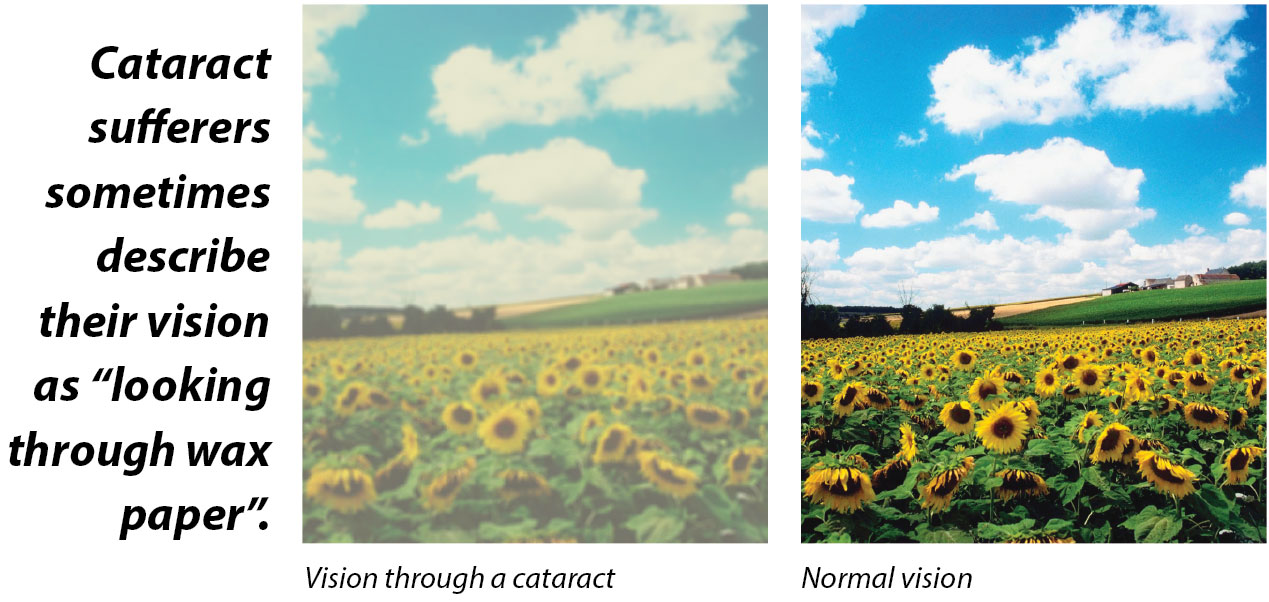Cataracts affect millions of people each year. In fact, by age 65, more than half of all Americans will have developed cataracts or already had cataract surgery. Cataract surgery is one of the most commonly performed surgeries, with millions of successful procedures being performed each year in the United States alone. The board-certified Ophthalmologists at Drs. Campbell, Cunningham, Taylor & Haun are experienced medical professionals who offer the most comprehensive care and advanced technology in East Tennessee for the treatment of cataracts.
What is a cataract?
A cataract is a clouding of the eye’s natural lens. Located just behind the iris, your natural lens helps focus light on the back of the retina, which sends the images to the brain. When the lens becomes cloudy due to the formation of a cataract, the images we see become distorted and unclear. When vision is significantly impaired (which often happens gradually with cataracts), then surgery must be performed to remove and replace the natural lens with a clear intraocular lens (IOL).
What are the symptoms of a cataract?
When cataracts are present, a variety of symptoms are often experienced. These typically include:
- Cloudy or blurred vision
- Double vision in a single eye
- Seeing halos around lights, especially at night
- Increased difficulty seeing at night
- Greater sensitivity to light and glare
- Noticing dim or faded colors
- Frequent changes to glasses or contacts prescriptions
- Difficulty reading/needing more light to read
These can also be a sign of other eye conditions. If you’re experiencing any of the above symptoms, it’s recommended you schedule an appointment with an eye care professional as soon as possible.

What causes cataracts?
 Most cataracts develop gradually with age, typically beginning to form around age 55 and worsening by age 65. Age-related cataracts can take many years before symptoms become apparent. Cataracts can also be the result of injury to the eye, inherited genetic conditions, certain health problems, past eye surgery, or long-term use of steroid medications.
Most cataracts develop gradually with age, typically beginning to form around age 55 and worsening by age 65. Age-related cataracts can take many years before symptoms become apparent. Cataracts can also be the result of injury to the eye, inherited genetic conditions, certain health problems, past eye surgery, or long-term use of steroid medications.
How do cataracts form?
As you get older, the eyes’ natural lenses become thicker, less flexible, and less transparent. Whether due to age or other medical conditions, the proteins and fibers within the lenses break down and clump together, causing the lens to become clouded. As the cataract continues to develop over time, that clouding becomes denser and your vision more impaired.
How are cataracts treated?
When cataracts cause a significant decrease in vision, the only way to treat them is through cataract surgery. Medical advancements in cataract surgery allow Ophthalmologists to perform this common procedure with little discomfort for the patient. The cataract surgery of today requires no needles or sutures and is performed with topical anesthesia administered through eye drops.
During cataract surgery, your Ophthalmologist carefully makes an incision and removes the clouded natural lens and replaces it with a clear artificial lens, or IOL. The incision then seals naturally. The majority of these procedures are outpatient and take less than an hour, being performed on one eye per surgery visit. With more than 18 million cataract procedures performed worldwide each year (including thousands at Drs. Campbell, Cunningham, Taylor & Haun), cataract surgery is one of the most common surgical procedures.
Are there different types of replacement lenses?
Yes! The technology behind intraocular lens implants (IOLs) has evolved over the years. In the past, only standard monofocal IOLs were available. These are still widely used today, but they only provide the best possible vision at one distance (typically not near vision). Therefore, most patients still need eyeglasses after surgery.
Today, you have the option to choose advanced lenses that can improve distance, intermediate and near vision so your dependence on eyeglasses after surgery can be greatly reduced – or even eliminated. Some lenses even correct pre-existing astigmatism. To learn more about the different types of lenses available, visit our Cataract Lens Options page.
What can I expect after cataract surgery?
Immediately after surgery, your vision may be blurry as the eye heals and adjusts. Itching and mild discomfort for a couple of days after surgery are common but rubbing or pushing on the eye must be avoided. Eyedrops or other medication may be prescribed to prevent infection, reduce inflammation, and control eye pressure. In some cases, your doctor may ask you to wear an eye patch or protective shield the day of surgery and possibly for a few days after surgery while you sleep. Post-op visits will typically be scheduled a day or two after surgery, the following week, and again in about a month so your doctor can monitor your healing.
What results can I expect from cataract surgery?
Cataract surgery restores vision successfully for the majority of people who elect the procedure. Most patients can expect their vision to begin improving within a few days after any initial blurriness subsides. You may notice colors seem brighter as you’re looking through a much clearer lens. While cataract surgery can greatly reduce your dependence on glasses and contacts, most patients need glasses (typically for near vision) at least on occasion after surgery. Your doctor will provide your final prescription or glasses once your eyes have completely healed, generally in one to three months.
What’s my next step to cataract surgery in Knoxville and East Tennessee?
Drs. Campbell, Cunningham, Taylor & Haun offer the most recent advancements in replacement lens technology in the region. If you suspect you have a cataract or are overdue for a comprehensive eye exam, schedule your appointment today by calling (865) 584-0905. We have offices in Knoxville and throughout East Tennessee for your convenience.
State-of-the-art ORA System [Click for more information] is now available in this area at Drs. Campbell, Cunningham, Taylor and Haun. ORA uses Wavefront-guided testing to provide real-time measurements of the eye during cataract surgery. This innovative “smart eye surgery” allows surgeons to instantly analyze results and make adjustments during the procedure for optimum results.




 >
>
Get Social